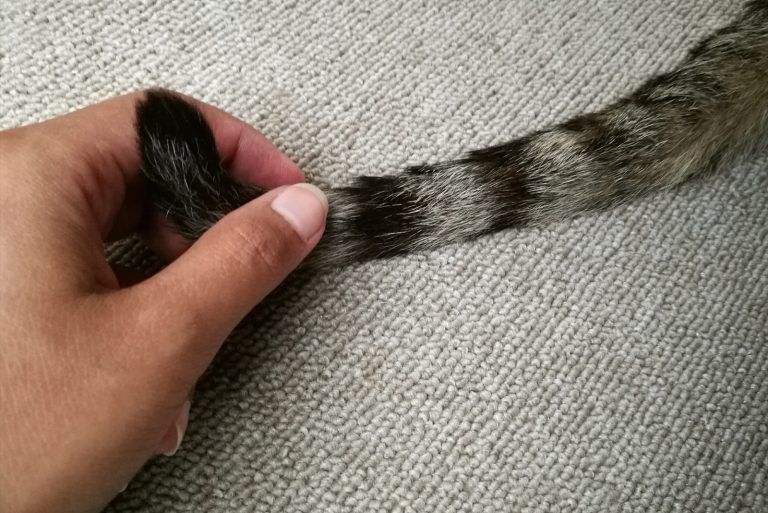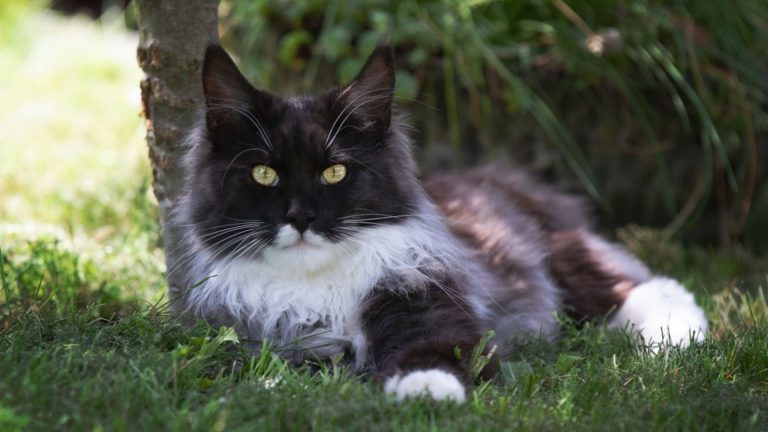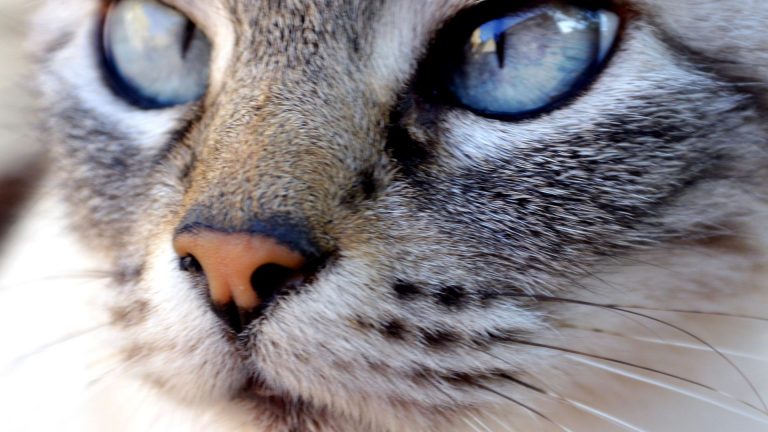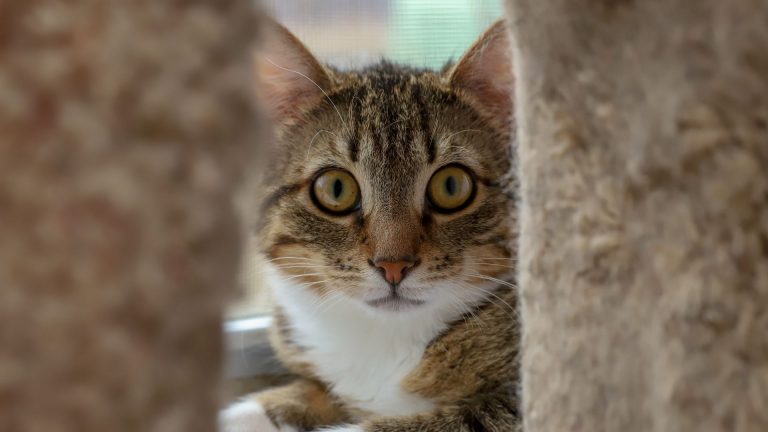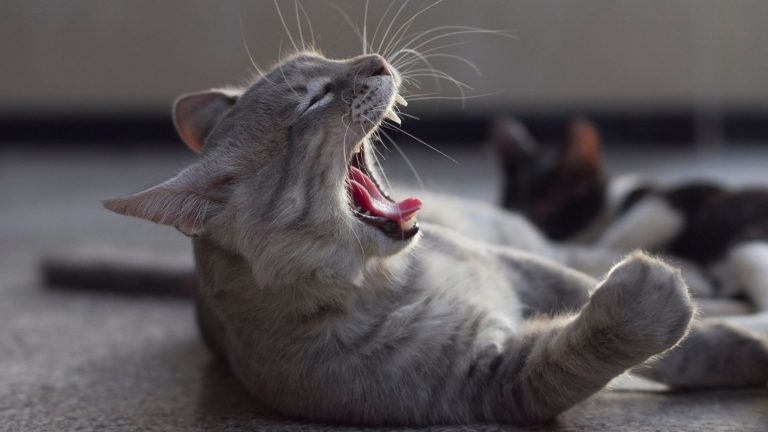Why Is Your Cat Throwing Up White Foam? The Vet’s Answer
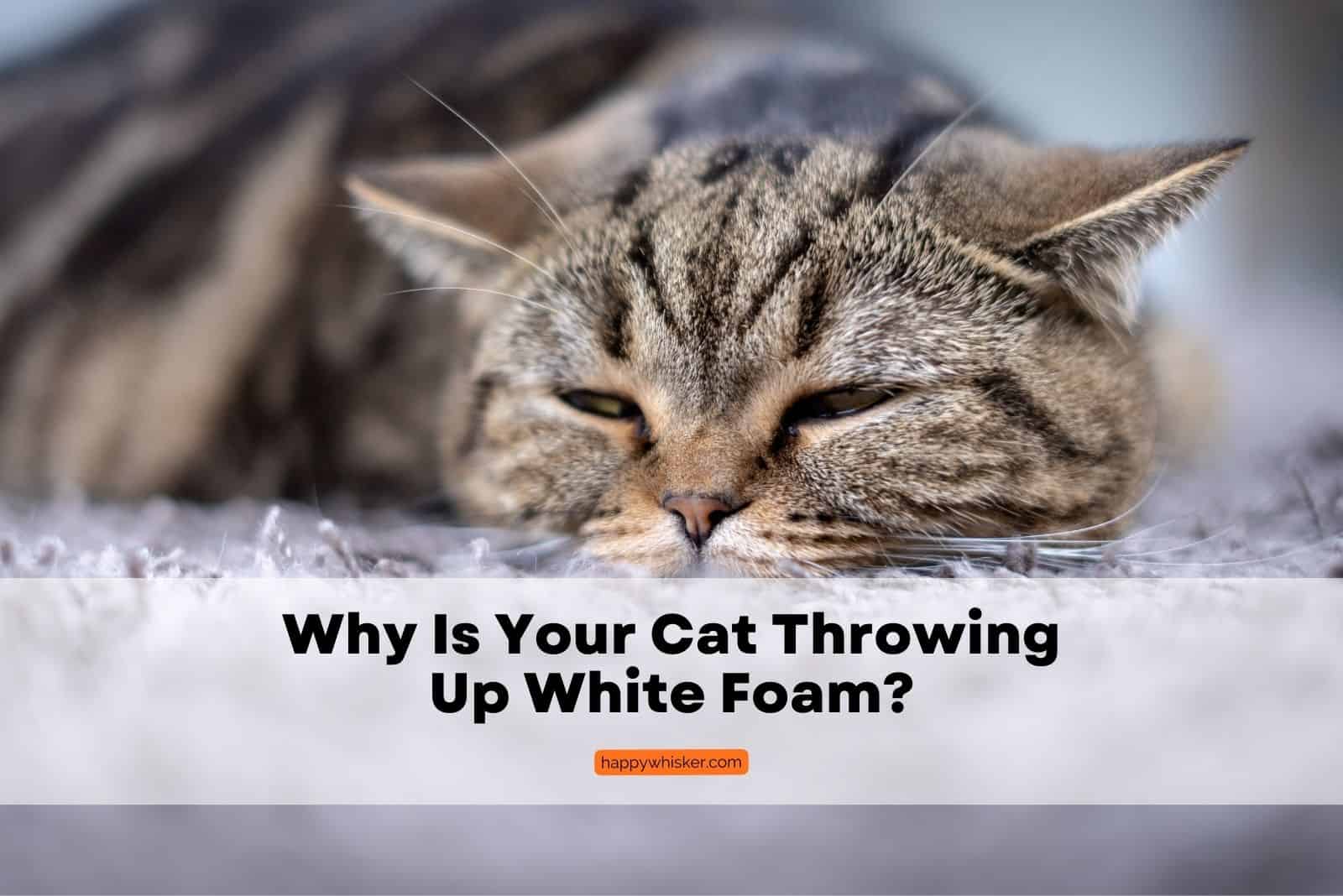
Have you ever seen your cat throwing up white foam? If the answer is yes, I hope that you didn’t ignore it. So, why am I saying this?
Well, a cat vomiting white foam may be more serious than you think. It’s actually a symptom of many different health conditions that are common for cats. All of these conditions require professional help and appropriate treatment.
Therefore, if you want to keep your kitty healthy and happy, make sure you read this article and find out the common causes of cats throwing up white foam.
Possible Causes For Cat Throwing Up White Foam
There are several possible causes for cats throwing up white foam. This symptom is not a joke; it requires your full attention. Each one of these issues requires a vet’s examination in order to determine the right diagnosis.
Without a proper diagnosis, the vet won’t be able to treat the cat properly. Therefore, you should monitor your cat’s behavior and condition, as well as other symptoms, and inform the vet about them.
So, if you want to learn more, check out the possible causes of vomiting white foam and how to treat each one of the conditions.
• Gastritis

One of the reasons why cats throw up white foam is a condition called gastritis. According to the sources, gastritis is stomach inflammation that can be acute or chronic.
I’ve seen many cases of cats with gastritis as it’s a very common condition in cats, especially those who eat unhealthy food that cats shouldn’t eat at all.
Besides throwing up white foam, cats with gastritis may show some of the following symptoms:
• Depression
• Loss of appetite
• Weight loss
• Increased water intake
• Traces of blood in feces or vomit
• Abdominal pain
Luckily, this issue can be treated, but it requires professional help. Therefore, if you notice some of these symptoms, it is best to take your cat to the vet right away.
How To Help?
The best way to help your cat with gastritis is to take it to the vet and let them do what they do best. Before providing the cat with any type of treatment, the vets will first run certain tests in order to make a diagnosis.
These tests include blood tests, abdominal X-ray, urinalysis, abdominal ultrasound, fecal tests, and similar.
After running these tests, the vet will be able to determine whether gastritis is the main cause of the cat vomiting white foam. Chronic gastritis will need more testing, while acute gastritis can be treated right away.
Acute gastritis can usually be treated at home by doing the following things:
• Providing your cat with small amounts of water but often.
• Feeding your cat a small amount of low-fat food which is easily digestible.
• Gradually increasing the cat’s food and water intake each day.
• In case of further complications, consult with your vet.
In case of chronic gastritis, the cat will probably need:
• Fluid therapy, in case of dehydration
• Anti-vomiting medications
• Gastrointestinal protectants
• Hairballs
The appearance of hairballs is a common occurrence for cats. As cats groom themselves frequently, by licking their hair, they also ingest the hair.
That hair usually passes with the stool, but if it builds up, it causes the formation of a hairball that the cat probably won’t be able to pass with the stool, but it will vomit it up.
So, if you notice your cat tempting to regurgitate hairballs and it vomits a white foam, it’s probably a precursor to a hairball, which means that there’s no need to worry.
Very rarely, cats can have more complications with the production of hairballs. However, if you want to reduce the number of hairballs, then there are several things you can do. Check them out further in the article.
How To Help?
In case you want to help your cat reduce the number of hairballs, then there are several things you can do to help them and make life easier.
• Brush your cat regularly in order to help it get rid of loose hair, especially during the shedding season. That way, the cat will ingest less hair while grooming itself and its fur will be clean and soft.
• Bathing your cat from time to time is another great thing cat owners should do. By bathing your cat, you also help them reduce loose hair and dead skin, keeping their skin and coat in a perfectly healthy condition.
• Try using over-the-counter dietary supplements.
• Feed your cat food with a special hairball formula that will help them easily digest the loose hair.
• Diabetes
Cornell Feline Health Center states that “Diabetes is a condition in cats which refers to irregular production or response to the hormone insulin.”
Due to the irregular function of this hormone, cats often have elevated glucose levels in the blood. This condition is more common for older cats, but it can also affect younger ones, there are no rules.
If you have an older feline that starts showing the two most common symptoms of diabetes: increased water intake and frequent urination, I advise you to contact your vet and make an appointment.
Diabetes may also result in increased appetite and weight loss. As glucose cells don’t receive enough energy, the body starts to break down other sources such as fats and proteins to provide glucose cells with energy.
Because of that, cats with diabetes often rapidly lose weight despite increased appetite. Now, if you want to find out how to treat diabetes in cats, then keep reading!
How To Help?
First thing first, if you suspect that your cat has diabetes or if you notice the common signs of diabetes, I suggest you quickly make an appointment with your vet and take the cat for an examination.
The vet will first examine the cat and perform a specific test in order to determine the issue. Based on the results, the vet may provide your cat with one of the following treatments:
• Dietary therapy
• Insulin therapy
Unfortunately, diabetes cannot be completely cured, but it can be kept under control. That means that your cat should have a high-quality life and the best possible care along with regular treatments.
• Indigestion
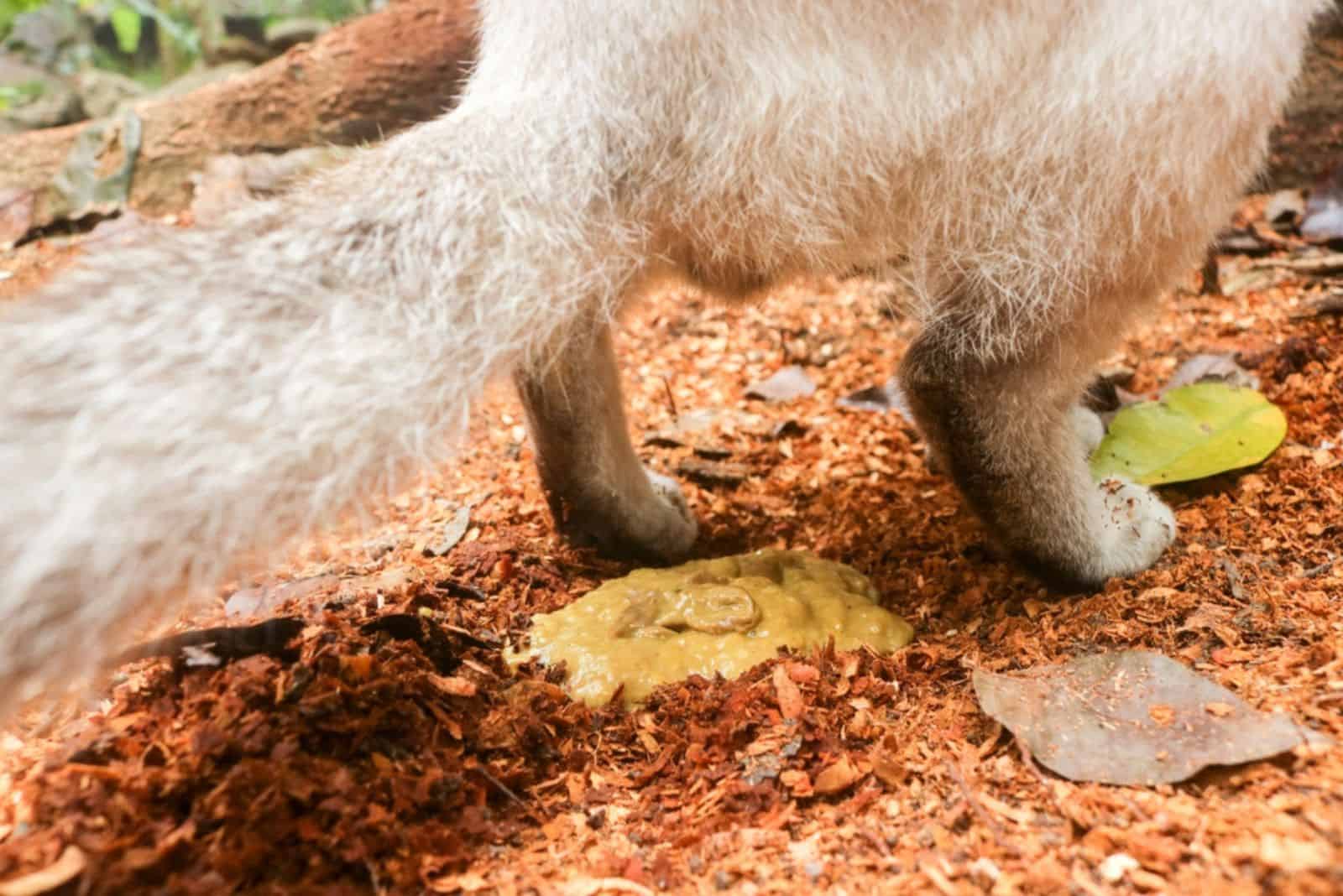
If you notice your cat struggling and vomiting white foam or even yellowish foam, the possible cause may be indigestion.
Our cats have sensitive stomachs, which is why they require a specific diet. If you don’t provide them with the diet that suits them best, that may easily result in issues such as digestive system issues, chronic vomiting, upset stomach, and similar.
A cat’s stomach produces different gastric juices and hydrochloric acid that help with digesting the food. But, if you don’t feed your cat regularly and on time, or if the cat skips the meal, it leads to gastric juice and acid build-up which can upset the cat’s empty stomach and lead to the cat throwing up white foam or similar.
Other signs of indigestion besides vomiting are
• Sleeping difficulties
• Loss of appetite
• Diarrhea
If something like this happens to your cat, it’s crucial you contact the vet and make an appointment to treat your cat properly.
How To Help?
The first thing that the vet should do after you bring the cat in for an examination is to find the underlying cause of the vomiting.
If it turns out that indigestion is the main thing that causes your cat episodes of vomiting white foam, the vet will probably provide your cat with a special diet.
In more severe cases, the vet may also provide the cat with medications such as anti-vomiting treatments, antacids, and similar.
As far as the diet is concerned, treating indigestion includes the following:
• Don’t feed your cat for 12 to 24 hours maximum.
• In the meantime, make sure they’re hydrated.
• Ensure that your cat is warm and comfortable.
• Slowly start introducing small meals which contain easily digestible food.
• Provide your cat with 4 or 5 extra small meals a day.
• Monitor your cat for any changes and contact the vet if you notice any worrying symptoms.
• Pancreatitis
This is a condition that refers to the inflammation of the pancreas. The pancreas is a small organ that is essential for its production of the hormone insulin and glucagon that serve to regulate blood sugar levels.
The pancreas may also be very helpful in breaking down fat or carbohydrates. So, if you notice that your cat is vomiting white foam, is weak and lethargic, dehydrated, has a fever or low body temperature, abdominal pain, or loss of appetite, it is possible that your cat is suffering from pancreatitis.
If that is the case, your cat requires a vet’s help in order to determine whether the condition is acute or chronic so that it can be provided with the proper treatment. Ensure you react right away, because if pancreatitis isn’t treated properly and on time, it can be life-threatening.
How To Help?
If you suspect your cat has pancreatitis, the vet will first perform laboratory tests, radiographs, ultrasounds, and similar types of tests.
Based on the severity of the cat’s condition, the vet will be able to provide it with different treatments. Therefore, if your kitty isn’t severely affected, it can be treated at home by following the vet’s instructions.
On the other hand, in severe cases, most cats need hospitalization as intravenous therapy is often required.
So, when treating a cat with pancreatitis, it’s crucial that the cat is hydrated all the time. I often prescribe anti-nausea medications for cats with pancreatitis as nausea usually leads to loss of appetite, therefore it’s crucial to treat nausea too.
In case you notice that your kitty has abdominal pain, it’s also important to pay attention to that and treat it properly. Furthermore, cats with pancreatitis also need special nutritional support, and a lot of rest, in order for their condition to get better.
• Liver Disease
According to the research, one of the health issues that cats are most prone to is liver issues. There are many different types of liver disease but the thing is that they’re usually not curable, they can only be treated in order to keep the issue under control.
Some of the most common liver issues in cats are hepatic insufficiency, hepatic lipidosis, inflammatory liver disease, cancer, liver cysts, and similar.
Cats with early stages of liver disease will often have symptoms such as
• Weight loss
• Loss of appetite
• Jaundice
• Vomiting white foam
• Diarrhea
• Excessive urination
• Fever
• Excessive thirst
• Yellow skin and sclera (whites of the eyes
As liver disease is not curable, it’s important to react as soon as you notice some of these symptoms, and treat the cat properly in order to keep its condition under control.
How To Help?
If you suspect that your cat is suffering from liver disease, it’s crucial to take it to the vet for an examination. After the vet examines the cat, they will be able to determine the exact cause and choose the best treatment option.
The most common treatment for cats with liver disease is an appropriate cat food diet including other supplements. Cats need a diet that is rich in calories but easy to digest; just make sure you feed them small but frequent meals.
Moreover, cats with liver disorders may also require different supplements such as vitamins and minerals. Still, you should pay attention to your vet’s instructions in order not to overdose your cat, which can be very harmful.
• Food Allergies
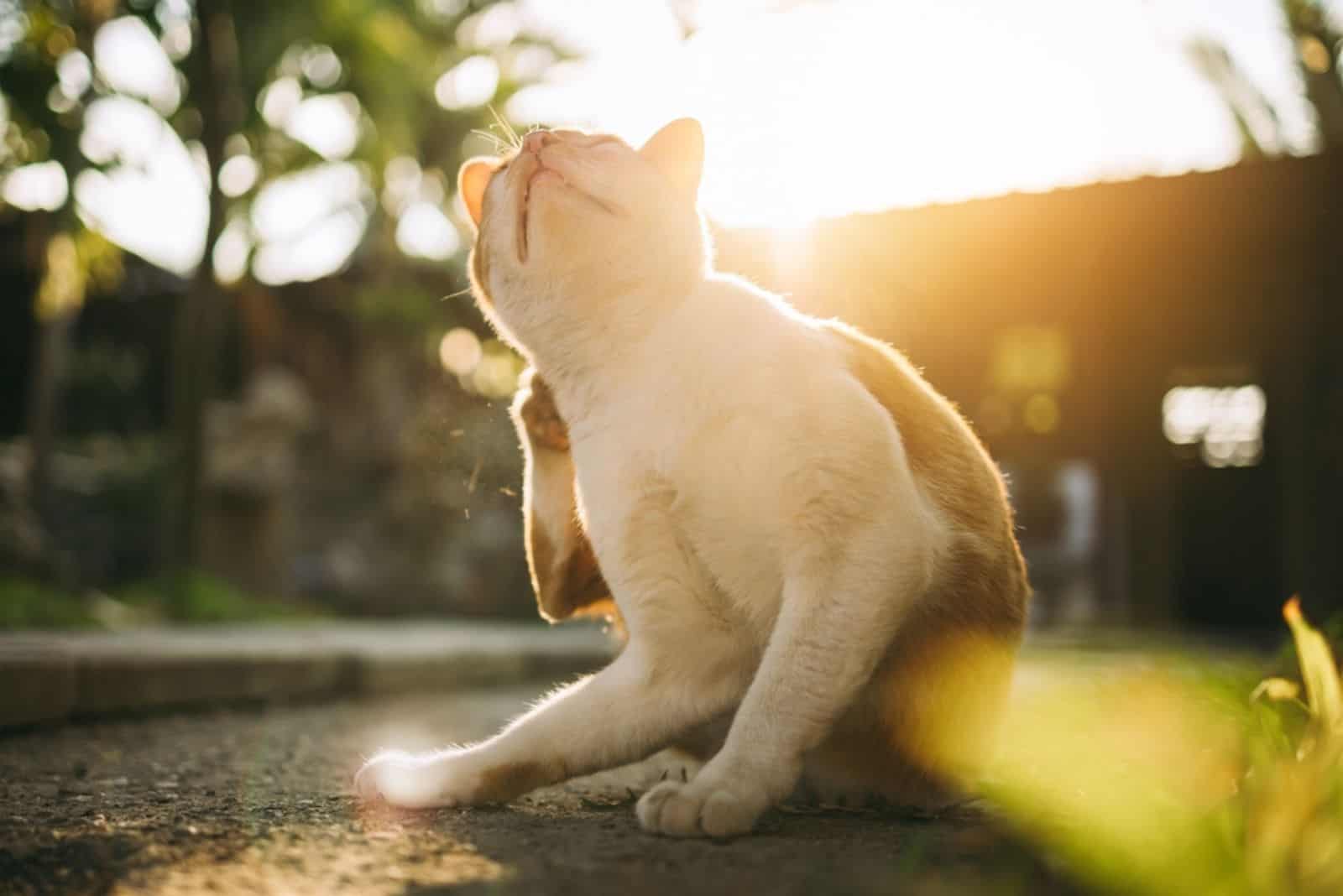
VCA Animal Hospitals states that “food allergy refers to an allergic reaction by the immune system to a specific protein or ingredient found in the food.”
Just like humans, our feline friends can be allergic to certain food types too. The most common food types associated with cat allergies are fish, chicken, dairy, and beef.
However, in order to develop an allergy to a specific food, the cat needs to be exposed to it first. Furthermore, cats may develop certain allergies after a longer period of time.
Food allergies need to be taken seriously if you want to take good care of your cat. Therefore, as soon as you notice some of the following symptoms, you should contact the vet and ask for help.
• Itchy skin
• Red skin
• Skin inflammation
• Hair loss due to scratching
• Vomiting white foam
• Diarrhea
How To Help?
Unfortunately, food allergies cannot be cured, but as long as you avoid feeding your cat food that causes allergic reactions it will be fine.
Firstly, the vet needs to determine the exact ingredients that cause your cat’s allergies. The best method for this issue is an elimination diet trial, however, it may take eight weeks.
After the vet determines the main cause of food allergies in your cat, they will also provide you with several cat foods that should be the best and the safest choice for your feline’s diet.
• Hyperthyroidism
Hyperthyroidism is a common condition for senior cats that refers to the overproduction of the hormone thyroid and an increased metabolic state.
One of the most recognizable signs of hyperthyroidism is vomiting white foam or diarrhea; however, there are other symptoms that point to this issue, such as:
• Increased appetite
• Excessive thirst
• Enlarged thyroid gland
• Excessive urination
• High blood pressure
• Weight loss
It’s essential that you contact your vet as soon as you notice some of the mentioned symptoms, as it’s necessary to treat the issue as soon as possible.
How To Help?
It’s crucial to monitor your cat’s condition and to inform the vet about anything which can eventually help them determine the main cause of the cat’s condition. They will examine the cat and perform the necessary tests.
When it comes to treatment options, hyperthyroidism is usually treated with an oral medication that can even be given life-long in severe cases.
The oral medications used for hyperthyroidism should contain methimazole, however, there are no approved medications for cats, only for humans, which aren’t safe for cats.
However, there is only one drug that contains methimazole as the active ingredient and it is FDA-approved. This medication is called Felimazole Coated Tablets and they can be safely used to treat hyperthyroidism in cats.
This medication can be given only if you have a vet’s prescription, and you need to closely monitor your cat if it uses these medications.
• Intestinal Cancer
If you wonder why is my cat throwing up white foam, another potential cause may be intestinal cancer. As Pet MD states, intestinal cancer, also called adenocarcinoma, is a malignant tumor that affects the cat’s gastrointestinal system.
Luckily, this condition is very rare in cats, but it usually affects older cats. The most common signs of illness like this are:
• Vomiting
• Lack of appetite
• Blood in the cat’s feces
• Weight loss
• Abdominal pain
• Black feces
If you notice some of these signs, it’s important you take your cat to the vet for an examination right away.
When it comes to intestinal cancer, this issue needs to be examined properly so that the vet can determine how to help the cat and which type of treatment would be most effective for it.
How To Help?
The first step in helping a cat with the previously mentioned symptoms is determining the right diagnosis. The vet will first perform a physical examination on your cat, and after that, they’ll perform diagnostic tests such as blood tests, X-rays, ultrasounds, and similar.
After these tests, the vet will be able to determine the diagnosis and will also be able to detect the location of cancer. In most cases, treating intestinal cancer includes surgery; the removal of the malignant tumor of the gastrointestinal tract.
However, in some cases, surgery won’t be possible, for example, in the case of adenocarcinoma of the stomach. In that case, the main treatment option is chemotherapy, but unfortunately, it’s not usually successful.
• Parasitic Infection
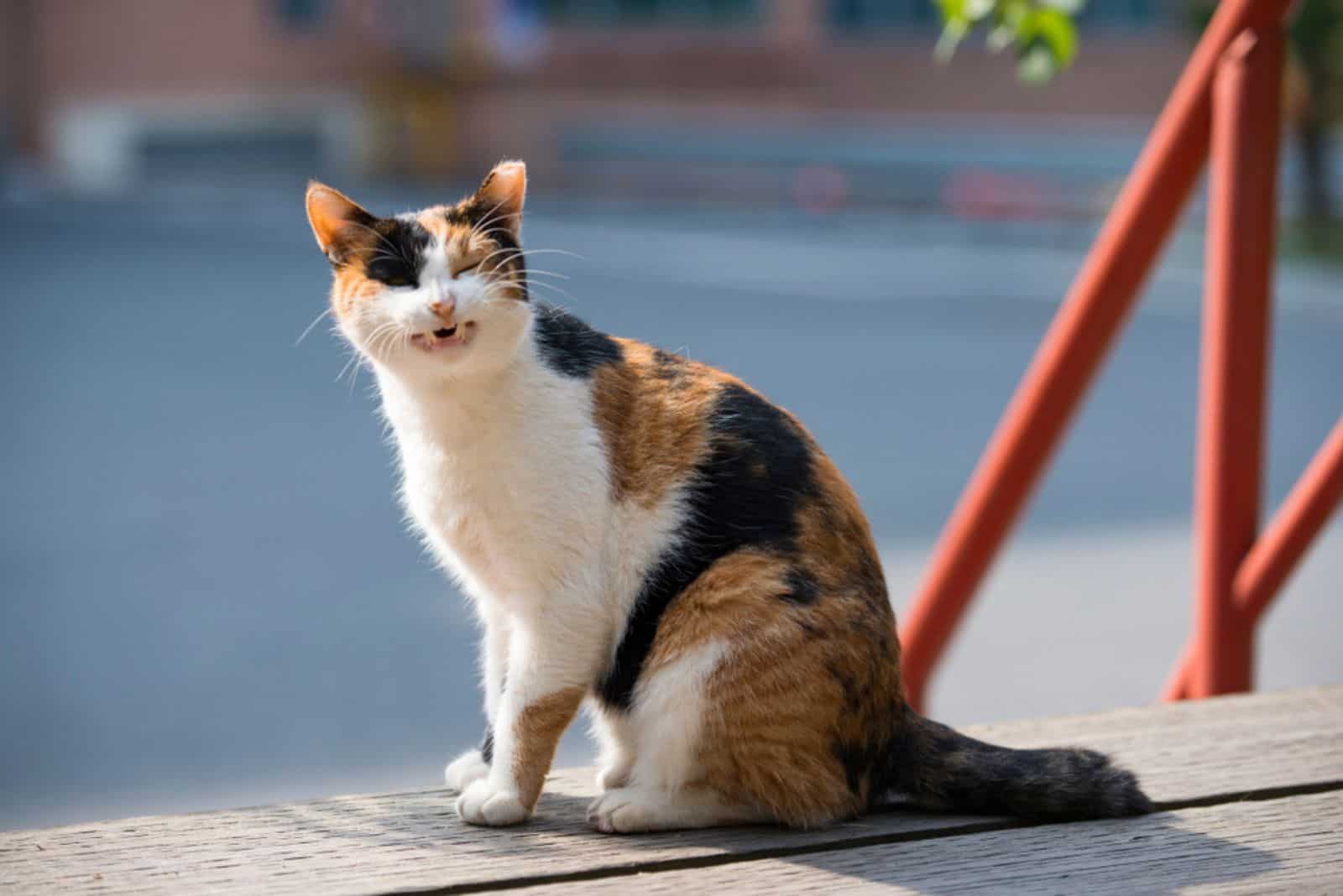
Another potential reason for your cat vomiting white foam is due to a parasitic infection. There are several different types of parasitic worms, these are parasites that can affect our feline friends, such as roundworms, intestinal worms, and others.
Because of that, and to keep our cats safe and healthy, it’s crucial to deworm our cats regularly because otherwise, they can have many negative consequences. The most common signs of parasitic infection in cats are:
• Vomiting white foam
• Intestinal blockage
• Diarrhea
• Blood in feces
• Loss of appetite
• Coughing
These symptoms can weaken the cat even more, making it prone to different health issues, including bacterial or viral infections. Because of that, deworming our cats and taking them to regular vet checks is of great importance.
However, deworming cats isn’t just good for them but also for humans, because according to the Cornell Feline Health Center, some parasites can even infect humans.
How To Help?
When it comes to parasites, you can provide your cat with preventive deworming treatment, thus decreasing the risk of your cat getting infected. However, if you notice some of the previously mentioned symptoms, then first you should take the cat to the vet.
Most of these parasitic infections can normally be treated and solved, however, if the cat is left untreated, unfortunately, it can end badly.
The vet will first determine the type of parasitic infection and then they’ll decide which treatment is best for the current situation. The vet will probably provide the cat with deworming medications several times, in order to prevent reinfection with the parasite.
If you want to prevent parasite reinfection, then you should also pay attention to good hygiene. For example, if your kitty is infested with parasites, make sure you keep it isolated in one room in order to prevent the larvae and eggs spreading around the home.
Carefully wash and disinfect the cat’s litter box when changing the litter, and pay special attention to the cat’s diet, avoiding raw meat, and similar.
• Gastroenteritis
Gastroenteritis is another health issue that can answer your question – why does my cat vomit white foam?
Gastroenteritis is actually an inflammation of the gastrointestinal tract. This condition can be caused by gastrointestinal infections with viruses, bacteria, parasites, and similar.
Before we continue talking about this health condition, it’s crucial to mention that gastroenteritis and gastritis are two different issues. Gastritis affects only the stomach while gastroenteritis affects both the stomach and intestines.
The most common signs of gastroenteritis are:
• Diarrhea
• Vomiting white or yellow foam
• Abdominal pain
• Weakness and lethargy
• Lack of appetite
• Gagging after eating or drinking
How To Help?
The first step of examination is to determine the right diagnosis by performing diagnostic tests such as abdominal ultrasound, X-rays, fecal test and urinalysis, blood tests, and similar. When the vet determines that the cat is suffering from gastroenteritis, they will be able to provide it with the proper treatment according to the cause of the gastroenteritis.
The vet will prescribe antibiotics if the cause of gastroenteritis is a bacterial infection. Moreover, the cat may also receive anti-vomiting medication or gastrointestinal protectants.
In this case, you shouldn’t feed your cat for 8-12 hours, but after that period of time, you should slowly start giving it small meals of highly digestible food several times a day. If you provide your kitty with the necessary diet and pay special attention to it, the cat will recover very quickly.
• Irritable Bowel Syndrome (IBS)
Irritable Bowel Syndrome (IBS) is another health issue that can affect the cat and lead to them throwing up white foam. IBS is a condition that refers to acute or severe gastrointestinal distress, which usually happens as a result of dietary changes, stressful events, allergies, and similar.
The symptoms that may help you recognize this issue in your cat are:
• Diarrhea
• Constipation
• Struggling to poop
• Abdominal pain
• Gas
• Nausea
• Weakness and lethargy
• Loss of appetite
• Weight loss
A cat displaying these symptoms requires professional examination and help. Therefore, you’ll need to make an appointment with your vet and let them do their job properly.
How To Help?
The vet will first provide the cat with a physical examination. In this case, it’s crucial to find the exact cause of this issue and to treat it. Some of the possible treatment options are:
• Intravenous fluid to prevent the cat from dehydrating
• Antispasmodic medication
• Laxatives or stool softeners to help with constipation
• Antidiarrheal medications
Furthermore, the cat will probably need dietary changes, including a short course of corticosteroids, such as prednisone, or antibiotics and similar.
Your job is to monitor your cat’s behavior and condition and follow the vet’s instructions if you want your kitty to be happy and healthy again.
• Kidney Disease
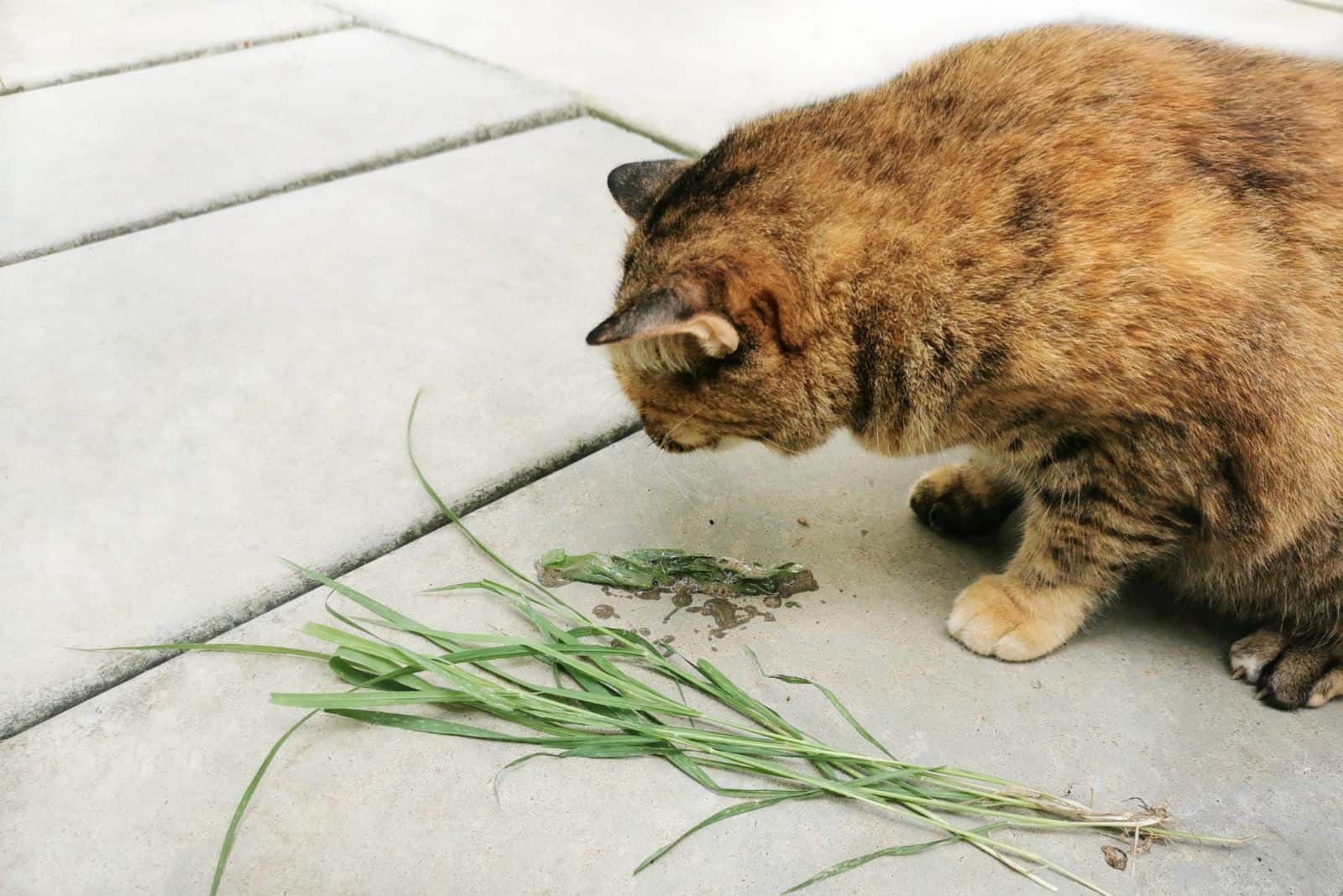
Renal Insufficiency or chronic kidney disease (CKD) is a common condition in cats, especially senior ones, according to the research paper on Chronic Kidney Disease in Aged Cats.
Senior cats with this health problem may often vomit white foam, but have other symptoms as well, including:
• Dehydration
• Loss of appetite
• Weight loss
• Increased water intake
• Weakness
Just as it is the case with liver disease, kidney disease cannot be completely cured, but it can be treated to keep the condition under control.
Therefore, if you suspect that your cat has chronic kidney disease, it’s crucial you take it to the vet so that you can start treating it properly and help the cat deal with this health problem.
How To Help?
To determine whether a cat is suffering from kidney disease or something else, you’ll need professional help. The vet will examine the cat and perform blood tests, urinalysis, and similar diagnostic tests in order to find the exact underlying cause.
If the vet determines that the cat has chronic kidney disease, they will provide you with several different treatment options.
One of the main treatments for this condition is dietary changes. Senior cats with kidney disease need a diet rich in vitamins, fiber, and antioxidants that can improve the cat’s quality of life. You can consult with your vet further on your cat’s diet.
Moreover, some cats may need oral medications to control hypertension or similar issues that may occur along with kidney disease.
• Inflammatory Bowel Disease (IBD)
Inflammatory bowel disease (IBD) is a severe condition in cats that refers to the inflammation and irritation of the cat’s gastrointestinal tract.
The main issue with this condition is that the inflammatory cells infiltrate the walls of the GI tract, thickening them and preventing them from absorbing or digesting food properly.
This issue can be easily recognized by the following symptoms:
• Vomiting
• Diarrhea
• Blood in feces
• Loss of appetite
• Weakness and lethargy
If you notice some of these symptoms, it’s crucial you take your cat to the vet so that it can be properly examined and provided with the appropriate treatment.
How To Help?
As soon as you bring your cat to the veterinary clinic, you should inform your vet about the cat’s condition so that they can get a better insight into the cat’s condition. After the vet determines the right diagnosis, the treatment will include some of the following:
• Dietary changes – you’ll need to feed your cat smaller meals but more times a day, with highly digestible food that is rich in essential nutrients.
• Medications – antibiotics are often used to treat possible infections, while corticosteroid or anti-inflammatory medications are often used to reduce the inflammation of the intestine.
• Intestinal parasite treatment may be required if it hasn’t been already done.
After the treatment, you should find a way to make your cat happy and comfortable. Ensure you pay close attention to its behavior and condition so that you can contact your vet in case of any important changes.
Final Thoughts On Cat Vomiting White Foam
In case you’re wondering why is my cat throwing up white foam, then this article is for you. If your cat is having this issue then you should know that there are many different potential causes for the cat vomiting white foam.
These causes may vary in how serious they are. However, each one of them requires proper examination and the right diagnosis in order to be treated properly.
Hopefully, this article helped you to prepare yourself or helped you know what you should do after seeing your cat throwing up white foam.
Make sure you pay attention to your cat’s health and see you next time!
Related Articles
• My Cat Keeps Throwing Up But Seems Fine – Should I Worry?
• Cat Swallowing A Lot – Symptoms, Conditions & Treatment
• 6 Possible Causes Of Cat Coughing With Tongue Out (Explained)

